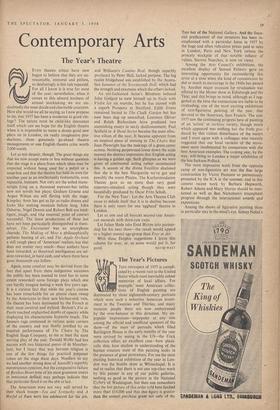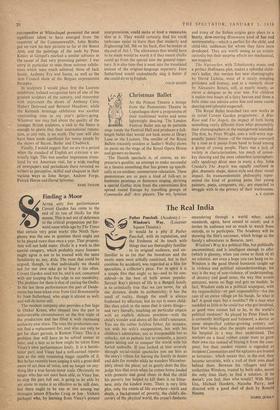The Year's Pictures
Tins retrospect of 1957 is compli- cated by a recent visit to the United States which must inevitably colour memories of local affairs. For example, most American collec- tions of English painting are dominated by those eighteenth-century portraits which were such a seductive American invest- ment in the Twenties and Thirties, and many museum people there are now embarrassed by the over-balance in this direction. My un- popular impressions—unpopular at any rate among the official and unofficial sponsors of the show—of the mass of portraits which filled Burlington House in the early months of the year were revived by seeing in the US—the Frick collection offers an excellent case—how plasti- cally thin, how shallow in understanding of the human creature most of this painting looks in the presence of great portraiture. For me the most exciting historical exhibition of the year in Lon- don was the Stubbs show at Whitechapel. It, is sad to realise that there is not one top-class work by this painter in any of our public galleries, nothing as good as the picture in the National Gallery of Washington, but then one remembers that the last picture of this order sold here fetched more than €14,000 and that this figure is greater than the annual purchase grant not only of the Tate but of the National Gallery. And the finan- cial predicament of our museums has been re- emphasised with a particulur force in 1957 by the huge and often ridiculous prices paid at sales in London, Paris and New. York (where the princely stockpile of that notable inflator of values, Stavros Niarchos, is now on view).
Among the Arts Council's exhibitions, the excellent display of Samuel Palmers gave an interesting opportunity for reconsidering this artist at a time when the kind of romanticism he did so much to encourage in the 1940s has passed by. Another major occasion for revaluation was offered by the Monet show at Edinburgh and the Tate; and this brings to mind, although as I sug- gested at the time the connections are liable to be misleading, one of the most exciting exhibitions of non-figurative painting of the year, that devoted to the American, Sam Francis. The year 1957 saw the continuing progress here of painting of an 'action' or tachiste variety, though much which appeared was nothing but the froth pro- duced by this violent disturbance of the waters and I must agree with a colleague who recently suggested that our local variants of the move- ment seem insubstantial by comparison with the best American examples. The coming year, by the way, will bring to London a major exhibition of the late Jackson Pollock.
The most impressive work from the opposite camp of non-figurative art was the fine large construction by Victor Pasmore so portentously presented by the ICA in the summer, and in this context recent work by Barbara Hepworth, Robert Adams and Mary Martin should be men- tioned as well as Ben Nicholson's triumphant progress through the international awards and expositions.
Among the shows of figurative painting three in particular stay in the mind's eye. Sidney Nolan's
xetrospective at Whitechapel presented the most -significant talent to have emerged from the rcountries of the Commonwealth; John Bratby put on view his best pictures so far at the Beaux Arts, and the paintings of the nude by Peter Kinley at Gimpel's marked a similar advance in the career of that very promising painter. 1 was sorry in particular to miss three autumn exhibi- tions which were much admired, those of Jack Smith, Anthony Fry and Souza, as well as the Arts Council show of the Belgian expressionist Permeke.
In sculpture I would place first the Laurens exhibition, belated recognition here of one of the greatest sculptors of the century, and remember with enjoyment the shows of Anthony Caro, Hubert Dalwood and Bernard Meadows, while the Kenneth Armitage exhibition was another outstanding miss in .my year's gallery-going. Whatever one may feel about the quality of the younger British sculptors, a visit to the States is enough to prove that their international reputa- tion, at -any -rate, is no myth.. The year will also have been made significant for many people by the shows of Bacon, Butler and Chadwick.
Finally, I would suggest that we are in a period when the standard of English art criticism is un- usually high. This was another impression stimu- lated by my American visit, for a wide reading of newspapers and periodicals there revealed no writers as perceptive, skilful and eloquent in their various ways as John Berger, Andrew Forge, Patrick Heron and David Sylvester.
BASIL TAYLOR











































 Previous page
Previous page